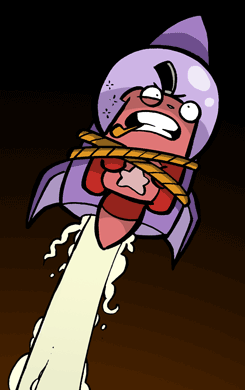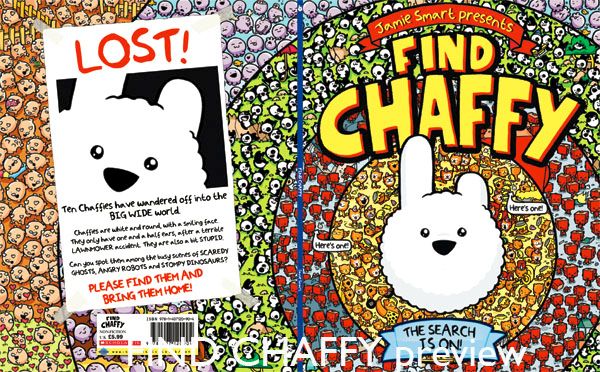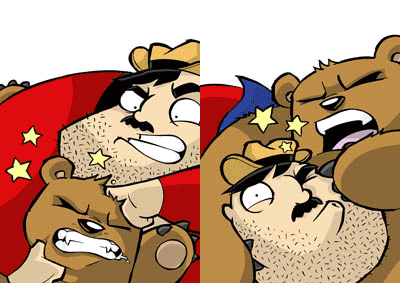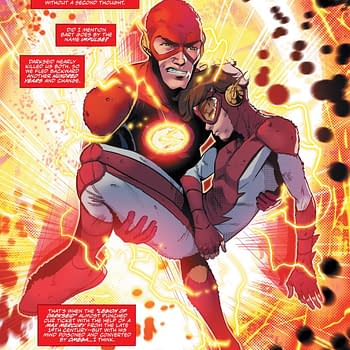Posted in: Comics, Recent Updates | Tagged: beano, dandy, desperate dan, Jamie Smart, Moose Kid, Phoenix Comic, The Phoenix
The Dandy, The Phoenix And The MooseKid: An Interview With Jamie Smart
Alasdair Stuart writes for Bleeding Cool
Jamie Smart has been one of my favorite comic creators for years. He's the man responsible for the wonderful Bear (He's Bear! He's Bear! He's made of human hair! You poke his nose and his head grows he's Bear! He's Bear! He's Bear!) and through that unleashing the most terrifying cat in comic history, Looshkin, on the world. He's also the creator of Corporate Skull, the best monster fighting/office worker finding the joy in their life at the expense of their face comic ever written and has had work in The Dandy, The Beano, The DFC and The Phoenix. Jamie is prolific, massively talented and at the cutting edge of UK children's comics. I talked to him about Moose Kid, his new project, and his career so far.

How did you get started making comics?
Like any cartoonist or comic artist, just by drawing tons and tons of them while I was growing up. You trace the work of your heroes, then begin to find your own style. I started sending work out to publishers as soon as I realized you could, from about the age of 13 onwards. Mostly got small illustration jobs here and there through art college but then my first paying comic strip gig was for a monthly cookery magazine. From there I went on to work for The Sunday Times and The Dandy, and I've been loving it ever since.
What comics influenced you?
When I was growing up I was big into Garfield, then Calvin And Hobbes (although to my shame, I initially wasn't keen on it). I used to read all the main UK children's comics – Buster, Dandy, Whizzer And Chips, Beano, Topper etc. I'm sure I just absorbed everything in there by osmosis. When I got to art college, I began reading Deadline, Tank Girl, and Milk And Cheese. I can't put into words how much those affected me, they really set me on the course I'm on now.
You've worked for several companies, but I first discovered your work with Bear from SLG. How did that title come about?
I sent them four different comics back in 2002 (I think?) and they chose Bear. And they were the first publisher I'd sent Bear to, it just felt like the right fit, so I was extremely fortunate that they took it on. Being given my own comic book series, to do whatever I want in, my brain nearly exploded. I was so excited.
You've worked both in print and online. Which do you prefer?
Both are fun. I think print, for me, still feels a little more special. Same as holding a CD feels like something solid, rather than flicking through a thousand songs on your computer. There's a chance to make a really nice package with print, a complete concept for people to treasure.
Digital has its own rewards though. The limitations are only what you can create, it's an infinite canvas to stretch across and will only evolve and improve as time goes on. It's great to be able to connect with your audience directly, and experiment with the form.
In an ideal world, for me, print and digital will not only co-exist, but be two parts of the same whole. Creating an idea will involve both mediums to complement each other.

What's the single thing you're proudest of to date?
I think I've been real lucky in the opportunities I've had, particularly that I've been allowed to work on mostly my own characters. Bear was probably my most exciting, and most personal, work. But reaching a much younger audience with my children's book Find Chaffy, or getting to really world-build with my weekly Bunny Vs Monkey comic in The Phoenix, I'm proud of them all.
Outside of my own characters, being trusted with Desperate Dan and Doctor Who have both been real honors, and I've loved every minute of it.

You've done a lot of work with The Dandy. How did it feel coming in to a title with so much heritage?
Oh amazing, and the privilege never left me the nine or so years I've been working there. It's such a big name, with such a rich history, it really makes you as a creator want to up your game and do the best you can. Besides Desperate Dan, I also drew a lot of my own characters for the comic, week in and week out, and was very involved in the redesign a couple of years ago. It's been such a big part of my working life, I feel very proud to tell people.
You were also one of the leading voices leading the campaign to try and save it's print edition. Why do you think it's so important to the British comic scene?
The Dandy went out of print after 75 years, and moved to digital only content at www.dandy.com. There was a lot of fuss when it announced the end of its printed version, myself and a lot of other artists were hauled onto national TV news, I got to write a few pieces for newspapers, and suddenly everyone was talking about this great loss to British culture. Thing is, many people feeling the loss hadn't bought the comic since they were kids. And their OWN kids were playing video games and with ipads, so hadn't really been introduced to comics. So there was a sense of grim inevitability about it all, that it wasn't something you could undo since as a culture we had all moved on.
As it happens, when the final issue of The Dandy came out, they sold out so fast they had to re-release it. They became collector's items on ebay. Clearly people wanted to grab a part of their history, of their youth.
But none of that helps the British comics scene. The only real comics around with original content and characters are The Beano and The Phoenix. Everything else is licensed properties, or TV tie-ins. It's no wonder the original content comics are struggling – they don't have merchandising ranges or TV shows to push them along (granted, The Beano does to an extent, but in comparison to the runaway success of Moshi Monsters magazine which has been trouncing all competition in sales, it's still a real struggle).
What I'm saying is lets not be nostalgic, because that's not going to save comics. Let's embrace what culture is now, and build on it. Losing the printed Dandy should be a catalyst to work out how to do that.
You've also done a lot of work with The DFC and The Phoenix. How is that different from working on a title like The Dandy?
The artists on The DFC and The Phoenix all came from very different places, embracing all styles of art and storytelling, so there's been quite a diversity in comparison to The Dandy. Which is great, and really interesting to get to know everyone (social networking has really enabled that). With The Dandy you do feel like you're joining a list of incredibly talented artists creating classic characters, so there's a little more pressure perhaps? But in terms of day to day working, both titles give creative freedom to their artists, which is the most important thing.
Let's talk Moose Kid for a moment. What led to you putting the project together?
It was the discussions which arose out of The Dandy folding, many UK comic artists were asking what they could do. And I think it's a really exciting time, with the internet and social networking and webcomics, the artists have really been given powers and responsibilities like we've never had before. Now if we want to create a character and find an audience, it's up to us, and it's up to us to be creative. And then, if lucky, convince a publisher we've already done the ground work.
That's where Moose Kid came from. It was a real urge in me to prove what we could do before it even got to a publisher. To show the strength of talent in children's comics, talent which isn't being seen without anywhere to show it. I talked a lot about what kids comics should be, about the directions I thought we should go, but this is me being less talk more trousers and actually doing something about it.
What sort of work are you looking for?
Moose Kid will celebrate characters, the kind of big exciting characters you would see in licensed comics or on TV. So I'm looking for artists who can create them. In particular, we're very much going to be a humor comic, so I want to go as big and as silly as we can. I think kids comics need to go a bit more unhinged, a bit more ridiculous, so I'm looking for that sense of hysteria in comics again.
Is there a time scale for the project as yet?
We're just collecting names of interested artists at the moment. And we have hundreds of names, though we're always looking for more. I'm working with a couple of very talented folk who will help me choose and edit the comic together, and make it something coherent.
So this is still early days. When we have put together a list of ideal artists, we'll approach them and ask what characters they want to create. Ideally, I'd like to have the finished issue online by the end of summer. Before winter makes everyone miserable.
What's your current focus with the project?
The end goal, the very end goal, is to get more people reading comics. Instead of competing against licensed titles, let's learn from them, and raise our game. Let's create original, brilliant, characters, and tell hilarious stories with them. And, perhaps most importantly, let's reach audiences who don't know comics. We're all very good at telling each other about our work, but we need to reach outside of our own group, and get comics back into the public consciousness again. More grown-up graphic novels are beginning to do this, to be recognized for literary prizes, but I'm keen we don't lose track of kid's comics too. Wide-eyed lunacy is just what we need back in vogue.
So that's the end goal. To do that, we'll have to build this into a brand, to get it reaching all over the place, splintering and finding homes in different media. Before that, we'd have to get a regular printed comic on the newsstands, which is an almighty uphill struggle. But if we can show what we're doing to an interested publisher or investor, we might get some way there.
But before all that, we want to make a brilliant comic. And put it online, for everyone to read, for free. And so that's what we're doing.
And let's work out the rest of it from there.
Jamie's website can be found at www.fumboo.com













